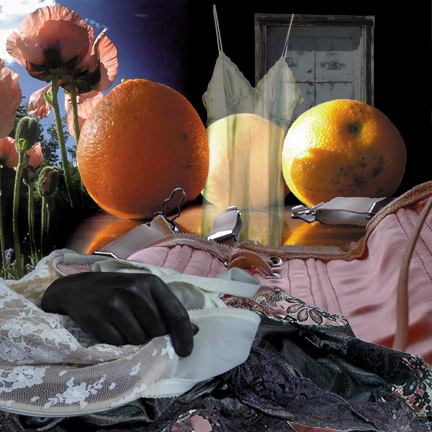
Joseph Kinnebrew might rank among the hardest workers in the art business, but he discounts the ultimate worth of his well-wrought finished objects. They are the carriers of his artistic philosophy which, to put it succinctly, is a celebration of ambiguity. The art of Joseph Kinnebrew is truly more than meets the eye. By design the surfaces and ostensible content of his paintings and sculptures is subversive. Kinnebrew has the right inveigling touch; he is something of a trickster who skillfully disarms the viewer.
The viewer always wants face value and Kinnebrew provides the semblance of
it: in one of Kinnebrew’s “surreal” paintings as intense
drama announces itself; there is eye candy, hedonistic beauty in a lush flower
painting; rigorous minimalist ‘less is more’ principles inform
an abstract sculpture and crazy, free-associative humor sculptures that bring
together disparate objects like a pear on a roller skate. Kinnebrew frustrates
these wishes to type his work according to category. He is using his mastery
of these different disciplines to capture and hold the viewers interest. But
he is trying to, hopefully, make you see past the surface and into a world
in which things aren’t really what they seem. On more than one occasion
he has invoked Alice in Wonderland as a paradigm.
The fact that his work is so various should be a clue to that fact that his
sincerity is not of the straightforward sort. Rather he is sincere about overturning
the usual, pat reading of things. For example he calls his figurative paintings
surrealist. But surrealism, in fact became a historical style decades ago,
as its founder Andre Breton predicted it would. Through familiarity (as well
as the horrors of the real world) it has lost its power to shock and its ultimate
value is as a reminder of an era when probing the unconscious was a thrilling
event.
Kinnebrew’s pastiche of Surrealism contains strong echoes of the masters,
especially Dali, Delvaux and Magritte. Original Surrealism capitalized on
the enthusiasm for Freud and the probing of the unconsciousness. The “surreal”
paintings of Kinnebrew almost all have dark, lurid backgrounds, the counterpart
of surrealism’s deep space. Kinnebrew’s pushing the fantastic
evokes black velvet paintings a kind of art that also conveys tackiness. Tackiness
is an ironic strategy; it makes his paintings alluring.
Paradoxically, the seeming intensity of the situations Kinnebrew creates signals
that not too much time should be spent on interpreting the paintings with
the standard art history criteria. The exacerbated situations are appearances,
appearances in the large sense in that nothing is absolute. It has always
been known that painting is illusion and Kinnebrew’s reminds us again
of this in a more intense way. A touchstone of reality, a true, enduring element
in the paintings, is the ubiquitous black and white checkerboard that takes
many forms. It is a reminder that things ineluctably become their opposite:
dark becomes light, male becomes female.
Kinnebrew’s flowers would seem to be more rooted in common reality.
Flowers are one of painting’s oldest subjects. But Kinnebrew endows
his flowers with a special sexiness; you don’t contemplate the passive
beauty but sense a restlessness to seduce. They also seem to be not-quite-grounded.
Without presenting the least sign of decay, Kinnebrew reminds us that flowers
are ephemeral and apparitional.
Kinnebrew’s startling range also takes in minimalist sculpture. (Not
shown in this brochure.) At first it would seem that Kinnebrew’s contribution
to this genre is devoid of the kind of drama that results from the clash of
disparate objects, But the abstract elements combine in odd ways, they often
huddle together, and we get the idea that despite their innate physical strength
they are at heart vulnerable.
The smaller bronze sculptures featuring pears would seem to be the essential
Kinnebrew. With the pear as a kind of surrogate, he can indulge in voluptuousness.
Other fruits may be round, but the pear has curves. Kinnebrew takes it out
of its familiar role as a placid still-life subject and gives it many chances
to kick up its heels, those heels being attached to shapely legs.
In always reminding us of the possibility of “something else”
or “another way” Joseph Kinnebrew is an unsettling artist. His
work is the 800-pound gorilla, impossible to ignore.
William Zimmer
New York City
January 2005
William Zimmer writing about Joseph Kinnebrew
(January 2005)
(William Zimmer has been an art critic for the New York Times for 25 years. He is well known in international art circles)

